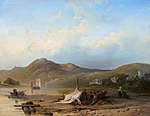Willem Roelofs

by Jozef Israëls, 1892
Willem Roelofs (10 March 1822 – 12 May 1897) was a Dutch painter, water-colourist, etcher, lithographer and draughtsman. Roelofs was one of the forerunners of the Dutch Revival art, after the Romantic Classicism of the beginning of the 19th century, which led to the formation of The Hague school. His landscapes, especially the early ones with their dominating cloudy skies, demure bodies of water and populated with cattle, are typical for the School of Barbizon.
Biography
Willem Roelofs was born in
In 1847, he was involved in the establishment of the artists society “The Hague Pulchri Studio”. In 1847, he left The Hague rather suddenly and went to live in
He unmistakably provided the spiritual impulse for the painters of nature that would later dominate The Hague school. Beside painting, he also occupied himself with
Roelofs died in Berchem.
Paintings
-
W. Roelofs, River landscape, 1842, oil on wooden panel,Gemeentemuseum Den Haag
-
W. Roelofs, Landscape in an Approaching Storm, 1850, oil on canvas, Rijksmuseum
-
W. Roelofs, Wooded Landscape with Stone Bridge over a River, 1852, watercolor on paper
-
W. Roelofs, Landscape with Trees and Water, c. 1855, oil on wooden panel
-
W. Roelofs, In 't Gein, c. 1860, oil-painting, in Teylers Museum
-
W. Roelofs, Landscape with cattle near Oosterbeek, 1867, oil on canvas, Amsterdam Museum
-
W. Roelofs, The Rainbow, 1875, oil on canvas, Gemeentemuseum Den Haag
-
W. Roelofs, Pasture landscape with cattle, c. 1880, oil on canvas, Rijksmuseum
-
W. Roelofs, Farm near the village Noorden, c. 1880-85, oil on panel, Rijksmuseum
-
W. Roelofs, Morning atmosphere - Pond near Loosdrecht (early morning)[2] 1887, oil on canvas, Rijksmuseum
References
- ^ a b Museum van Boijmans Beuningen. "Willem Roelofs". Collectie Boijmans,nl. Retrieved 17 February 2012.
- ^ "Plas bij Loosdrecht, Willem Roelofs (I), 1887".
External links
 Media related to Willem Roelofs at Wikimedia Commons
Media related to Willem Roelofs at Wikimedia Commons Quotations related to Willem Roelofs at Wikiquote
Quotations related to Willem Roelofs at Wikiquote- biography notes and dates of Willem Roelofs, in the Dutch Archive R.K.D. in The Hague
- Overview of his works at the Nunspeet Museum website
- 55 images of paintings by Willem Roelofs, on 'The Atheneum'
- 180 free images of Roelofs' paintings, drawings and prints, in the Rijksstudio of the Rijksmuseum, Amsterdam










![W. Roelofs, Morning atmosphere - Pond near Loosdrecht (early morning)[2] 1887, oil on canvas, Rijksmuseum](http://upload.wikimedia.org/wikipedia/commons/thumb/a/ac/Willem_Roelofs_-_Plas_bij_Loosdrecht.jpg/150px-Willem_Roelofs_-_Plas_bij_Loosdrecht.jpg)